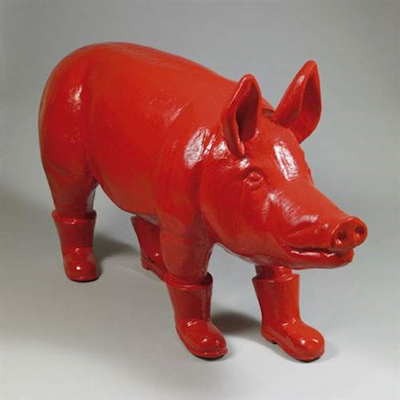
Details
Artist
Styles
Edition of 200 - Cement in custom-made wooden box (painted white) - Unsigned and unnumbered - In mint Condition // Maurizio Cattelan's L.O.V.E. (1:28) (White) is a striking small-scale sculpture, a 1:28 replica of his iconic monument unveiled in Milan in 2010. This piece, measuring 40 cm in height, is crafted from cement and presented in a custom-made white-painted wooden box. The sculpture depicts a hand with its fingers folded down, leaving only the middle finger raised in a bold and defiant gesture. The minimalist white surface enhances the statue's provocative nature, highlighting the contrast between classical monumentality and contemporary rebellion. Known for his subversive art, Cattelan challenges societal norms and authority with L.O.V.E., making this edition of 200 a powerful commentary on resistance, freedom, and expression.
L.O.V.E. (1:28) (White), 2010
form
Medium
Size
40 x 18 X 18 cm
- Inches
- Centimeters
Edition
Price
Details
Artist
Styles
Edition of 200 - Cement in custom-made wooden box (painted white) - Unsigned and unnumbered - In mint Condition // Maurizio Cattelan's L.O.V.E. (1:28) (White) is a striking small-scale sculpture, a 1:28 replica of his iconic monument unveiled in Milan in 2010. This piece, measuring 40 cm in height, is crafted from cement and presented in a custom-made white-painted wooden box. The sculpture depicts a hand with its fingers folded down, leaving only the middle finger raised in a bold and defiant gesture. The minimalist white surface enhances the statue's provocative nature, highlighting the contrast between classical monumentality and contemporary rebellion. Known for his subversive art, Cattelan challenges societal norms and authority with L.O.V.E., making this edition of 200 a powerful commentary on resistance, freedom, and expression.
What is Kitsch?
Kitsch is a term used to describe cheap, commercial, sentimental, or vulgar art and objects commonly associated with popular culture. The word is borrowed from German, where it originally means trash. Since the 1920s, kitsch has been used to denote the opposite of high art, often implying that the work lacks sophistication or artistic merit.













